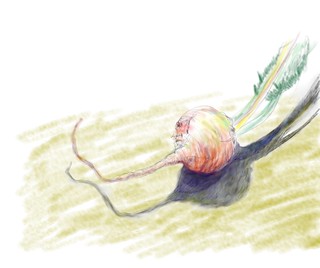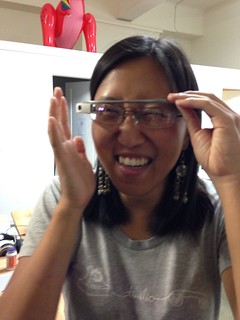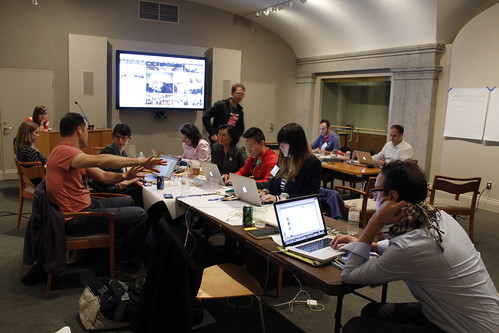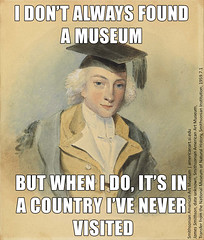When I was in high school, I thought we were supposed to see clearly into the future, where decisions would be made at regular intervals…
So I began my talk to Louisville High School, an all girls school in Woodland Hills California, where I spoke this past week about my life, my career and some thoughts about the future. When I was in high school, also at an all girls school, I expected to be able to see choices clearly ahead of time. This is not my life.
In my life, those choices that made a difference have only been clear in hindsight.
The visual pun, which I didn’t expect anyone in the audience to understand was that my first slide is a photo of a hall in EEOB, the old Executive Office Building, right next to the white house. It is no longer completely strange for me to walk down those halls as a Presidential Innovation Fellow. This is not my life. It’s a place I’m visiting, while I work to help our government apply technology to solve critical challenges. The straight, official looking hallway is the perfect metaphor for how many adults present the prospect of a bright future to a college prep school student. Life is murkier in reality.
Introduction
I did not plan to have an exciting life as a high tech entrepreneur.
I will talk for just a few minutes about my early life, and how I got started in computer programming, and then the winding path that led me through entrepreneurship, to doing a lot of creative software development.
First, I have some questions for you:
- Has anyone in the room developed software before? one hand goes up
- Who has written any code at all? a few more hands are raised, and I ask them to keep their hands up
- Javascript? …Scratch? …Logo? …?Visual Basic? more hands go up as I mention each language
- HTML? …CSS? at least half the audience has their hands raised now
- What about anyone who has written an Excel formula? now we’ve got most of the audience raising their hands
- Email filters? I guess kids don’t use email much anymore
There’s a spectrum of computer programming. What we’re seeing today is that the advanced features of many software applications require programming skills, even if they don’t call it programming.
I ask if anyone can define software… to tell me and tell their peers, what software is? One kid does a very good job of it. Now they are ready, I think, to hear about some fancy software I’ve created and feel some kind of connection to the process, I hope.
There’s a good chance that every person in this room has used software that I developed and you’ve most certainly seen its effect on the world.
You should know that software is a team sport. I’ve played on some great teams.
What I’m probably most proud of is my work on After Effects. You’ve probably seen the result of After Effects in the movies. This was the first breakout success software that I built.
I also worked on both Shockwave and Flash. I was on the original Shockwave team, and then worked on Flash later.
I will tell you a little bit about how it all happened and how I didn’t see it coming.
Early Life
I was born in New York City. I lived there for two years. My family lived in different places all over the world. When I was in fourth grade, we lived in the Philippines, and I learned Tagalog. I went to a Catholic school, with 2,000 girls, and only two Americans in the whole school.
At that time, the Filipino people generally credited America with giving them their freedom after WWII, and I was treated like a celebrity, which was mostly fun and occasionally mortifying.
I later learned that America actually contributed to the oppressive regime under President Marcos. At that time, Martial Law was in effect. I didn’t really understand what that meant as a kid. There was a curfew, but I had to be home by dark, anyhow.
The next year, we moved to El Salvador, where I became fluent in Spanish, which then completely replaced Tagalog for me. El Salvador, at the time, was in the midst of a civil war. The very, very rich in El Salvador were oppressing the very, very poor — taking away their farms, often killing them, and the United States was providing arms to a corrupt government.
I was horrified by the actions of my country. When I came back to the US, I read in the newspapers that the US was fighting Russian communism in El Salvador. That’s was not what I learned was going on when I was living there. I was dismayed by the incomplete truths and misinformation I read in the newspaper.
As a teenager, I protested on Washington. I got very involved in activism against US foreign policy. I thought that I would have a career in International Relations. I wanted to change the world for the better. I felt that my parents’ generation had created a mess. It was my generation’s responsibility to fix that.
Meanwhile, my mom was laid off from teaching and decided that she was going go into the next big thing and sell computers. She brought home an Apple II, which at that time, came with a BASIC manual. I read the book, followed the steps, and learned how to do high-resolution computer graphics, which looked like this at the time.
![]()
I would program the computer to draw lines and I thought this was really neat. A lot of the people that I knew, assumed that I would go into computing as a profession, but I felt that a career in computing would be like having a career in Rubik’s cube. It’s really fun, but is this what you really want do with your life?
I didn’t think at that time that computers could solve any really significant problems in our world. Of course, I was wrong, along with a lot of other people who couldn’t see what was going to happen. Though there were some people that definitely did.
Career Path
Next, I will take you through a very brief tour of my career path. I will specifically highlight four decisions I made that made a really big difference.
From those four decisions, I’ll introduce the four life lessons that I want to impart to you today. I made a thousand, a million, decisions – you never know which decision is going to make a difference, but these are the four that did for me.
Four decisions, four life lessons
My big first decision was picking a college. I decided to go to Brown University. Most people who go to college have no idea what they really want to do. I picked Brown because Brown taught 13 foreign languages. I wanted to learn all of them.
I was really interested in how, when you speak a different language, you think to say different things and it influences your choice of words. It affects the connotation of what you say, and that that is responsible for a lot of misunderstandings in the world.
I audited some languages classes. The modern language classes taught literature, which was interesting but not really my passion, so I didn’t take those classes.
I thought “maybe what I want to study is linguistics.” but the linguistic classes, at the time, at Brown taught dead languages. They taught Latin, Sanskrit, Ancient Greek, which is again, somewhat interesting, but not really my passion. So, I thought “well, maybe I’m not that interested in language”, which absolutely the wrong assessment.
I did hear some great advice: take classes in college based on the teacher, not the subject.
Lesson #1: Learn from Great Teachers
I studied studio art, inspired by my teacher, Marlene Malik, who taught me that to create, we must also see, and that our work does not stop at the edge of the canvas, it is affected by its placement in a room, on a wall — the world provides context.
I also studied computer science which I took as a backup ’cause I figured if I’m getting an art degree, I better do something practical.
I still enjoyed programming, but could not imagine it being my career.
I had taken a year and a half off between high school and college, which caused me to graduate in December. The summer before my last semester, I joined some college friends to start a company called The Company of Science and Art (CoSA).
Lesson #2: Work with Great People
The team that I worked with were really great people. In some ways, these colleagues saw things in me that I didn’t even see in myself.
It had a huge effect on my expectations for the rest of my career, that my first adult work experience was with people who had mutual respect for each other, where we learned things from each other, where we created together. That was a really valuable experience and we ended up creating After Effects together.
I left CoSA right before After Effects was released because I was in love. My then boyfriend and I had decided that we would move across the country when I graduated. I delayed that for a year and a half, but then finally, I said, “Alright, this company, I love it, I’m having fun, but I don’t know if it’s ever really going to pay the rent.” Again, I was wrong about that.
We bought a telephone van and we packed up all our stuff and moved to California. I had gotten a job at Apple Computer, which I thought was pretty hot.
It was for product that they wouldn’t even tell me about when I applied for the job. In networking, which I thought was really interesting. I hadn’t studied that in school, the way that the computers talk to each other. It ended up being the worst job I’ve ever had in my life. It was terribly boring and the product was a dismal failure.
I did meet a great person there, Harry Chesley. I learned from him about Internet protocols. He was at SRI when TCP/IP was invented, which is the fundamental layer of the internet that everything runs on.
He told me stories about how they invented all this stuff and what it was like back when there were four computers on the Internet. I loved working with Harry, but I just really didn’t believe in what we were building. I ended up going back to CoSA, just three weeks before CoSA was acquired by Aldus, and then nine months later, Aldus was acquired by Adobe.
I found myself, once again, at what felt like an enormous company. It was probably 1,200 people at the time. I just felt like another cog in the machine, and I didn’t want to be there.
At that time, Harry had gone to this company called Macromedia to work on a product called Director and figure out how to make it work for interactive television.
By this time it was 1995 which was two years after the web was standardized, right around the time that Netscape had broken off from NCSA, a research institution where it had started. The Web was this very technical, academic endeavor. Most industry people thought that cable TVs, were going to evolve into interactive television – they called it ITV, where people would be using their remote controls with interactive film and that that would be the next big thing.
Everybody I had known who worked on an ITV project had been laid off two years later. So I said, “Well Harry, I’m really excited to work on your project, but I really like this idea you have of prototyping it on the Internet, and if I can work on the Internet side of it, then I’ll take the job.” And so he convinced his boss to have two people work on the internet and two people work on ITV. I signed up to Macromedia in June 1995 before they had a website. Three months later, we were all working on the Internet, and we released Shockwave, three months after that. It turned out to be a good thing to learn about the Internet in 1995.
Lesson #3: follow your heart
The direction that your heart is pointing may not be the right direction, but the key thing about following your heart is when you get to the right place, you will know it. And that’s what your heart tells you. The path may be winding. Pay attention to what you do outside of your work because that’s going last much longer than any particular job and the people that you connect to outside of your work are as valuable, more valuable, than the people you’ll know in your career.
I had followed my heart and married my college sweetheart, and I kept switching jobs every couple of years till I found myself in a good place. In 1995, I had the opportunity to work with Netscape’s APIs and release one of the very first plugins that made it so that you could do audio, and motion graphics, and interactivity without a full page reload. And that was really exciting. I was part of the rise of the Web.
One of the things that I had learned from Harry is that the internet was actually created… Does anybody know when the internet was created?
The Internet was invented in the United States during the late 1950s to the 1970s by a group of researchers and scientists at the Advanced Research Projects Agency (ARPA). On the October 29, 1969, computers at Stanford and UCLA connected for the first time using the network then called ARPANET.
The Internet came out the information technology from World War II. The government wanted to create a communications medium that would survive a world war. One of the reasons the Internet is tremendously resilient is because it was designed to survive war. Any node can go down and as long as some parts of the Internet are alive, then people can communicate.
I was struck by the fact that what came to consumer excitement was mostly publication, what we used to call “brochure-ware.” Most of the commercial Web was these pages that would be little more than product brochures – the glossy printed promotional material that you might pick up at a retail store or receive in the mail.
I got excited about actually creating software that would allow web applications to communicate with each other in real time. My first attempt was an ill-fated project called the Shockwave Multiuser Server, which was used for chat applications and multiplayer games. Later I joined Johnathan Gay on the Flash team to create Flash video. We created two-way audio and video. People built a lot of applications that looked like this and of course, what was enormously successful was the broadcast video that enabled sites like YouTube.
I saw the internet go from 16 million users in 1995, which sounds like a lot, but most people you knew didn’t really know what the internet was — most people weren’t using the internet. Then in the 2000s, it became a household term. Everybody had an email address. Everyone could access the web.
I reflected on my career and I thought to myself, I’ve built software that’s used by hundreds of millions of people but I’ve never set out to build a piece of software that I didn’t know was possible. I’ve never really taken a risk in my career. I’ve taken risks like moving across the country, taking a job that I didn’t know whether it was going to pan out. But that’s not a real risk, because then I can just get another job. I had skills and I knew that I was working in an industry where there were plenty of interesting jobs available.
By this point, I was then working at a private company as a Director of Engineering, leading a team of about 15 or 20 people. I decided that I wanted to start a new company. Maybe I didn’t know the people that I wanted to start a company with. Maybe I didn’t know what the product was going be. And maybe I didn’t know what technology I wanted to learn next. I decided to take a year off to do independent consulting while I found or created my next startup.
I wanted to attempt things where I had no idea whether I have the capability of doing this thing, but I will think through what will happen if I fail and I’m not going to do anything if I can’t live with the consequences.
Lesson #4: Take Risks
I set out on this path and I found that often, what I would have thought about as a failure and been afraid to take a step because of that potential failure, actually wasn’t that bad. Sometimes there was no bad outcome at all.
Sometimes I would be worried about what would happen at a meeting with someone important and influential in the industry. I would think to myself: the best outcome would be if we ended up with a good contract with this company. The worst outcome is that they don’t need our services and I have had a conversation with an interesting and influential person.
My willingness to take risks enabled me to accomplish things that were much bigger and bolder than I’d ever tried to do before. I created a mobile software development company, called Blazing Cloud. I learned how to be a CEO, though I always made time to write code and stay in touch with technology.
This Year
Early this year I found myself faced with an unexpected decision. I learned about a program that paired industry experts with innovators inside government. The CTO of the United States, Todd Park, asked me to apply. How many of you knew we had a CTO of the United States of America? (zero hands raised) He’s pretty amazing. He convinced me that I could have a big impact. I also felt that the changes that are being made in government today in terms of technology policy are unlikely to happen under any other administration.
There’s a sense of urgency. Our government, our world, has some big problems — technology isn’t the solution, but it can help if applied effectively. I applied to be a Presidential Innovation Fellow.
On June 15th, I went to Washington to work for six months at the Smithsonian Institution, also working with the Office of Science and Technology Policy on the Open Data Initiative. On May 9th, President Obama declared that all government data would be open by default. Unless there is a good reason for privacy, data produced by our government with our tax dollars will be free to citizens to use for any purpose. There’s great precedence that open data fuels industry and stimulates the economy — from satellite data that powers maps on our phones to weather, geological and census data. The Innovation Fellows are working across dozens of agencies to create effective systems to implement this open data policy.
At the Smithsonian, we have a unique challenge. The Smithsonian Institution has 19 museums, 15 archives, 23 libraries, 9 research centers, and a zoo. We have over 137 million physical objects — from artworks to natural history specimens — and over 136 feet of archival material. Those are papers stacked in file folders.
I am working on a team that is creating a way to turn images of manuscripts or journals or specimen labels, often written in cursive, into machine-readable text that can be searched and made available to the vision-impaired or future generations that aren’t learning cursive in school.
We have the opportunity to look at history through primary sources. Digital volunteers can identify connections that tell new stories. Physical specimens, collected over hundreds of years, can be made available for modern data analysis.
Industry Trends
I’m excited about this new kind of software like I’m working on at the Smithsonian. You know this software, since you all use Facebook — social networks are in this same category. The code is only part of a system that doesn’t function without people and the data that those people create and sometimes data from other sources as well. Things are different now. You have grown up with assumptions that will let you see opportunities that people my age will miss, since this is all new to us.
I see opportunities in this new technology that are very exciting. Software is collaborative. After hundreds of years of specialization, there is huge opportunity in interdisciplinary approaches. We’re seeing innovation between the tradition disciplines. Also, open source is exciting. You can look at source code for thousands of projects. You can learn from it and contribute to it.
Software is distributed. Our world has software everywhere and it’s beginning to cooperate and work together. We need to be careful of the implications, and be aware of this new kind of power we can harness. Computing has become very small with tiny devices from a FitBit to tiny robots smaller than a fly. Software also has vast storage capabilities. Our ability to collect data far outpaces our ability to process it and know what to do with it.
Closing Thoughts
On this anniversary of Martin Luther King’s “I have a Dream” speech at the March on Washington in 1963. I would like to share my favorite quote of his that speaks to how we need to consider the impact of what we create with technology.
“Through our scientific genius we have made of the world a neighborhood;” and he was talking about jet planes. This is so much more true today. “…now through our moral and spiritual genius we must make of it a brotherhood… We must all learn to live together as brothers or we will all perish together as fools.”
And finally, I want to leave you with some words from Alan Kay who said “the best way to predict the future is to invent it.”

 We are more than the sum of our efforts. Software can now enable a collective intelligence. It can be applied without direction for entertainment or social engagement in a social network, like Facebook and Twitter, or to serve an individual purpose, as with crowdfunding platforms, Indiegogo and Kickstarter.
We are more than the sum of our efforts. Software can now enable a collective intelligence. It can be applied without direction for entertainment or social engagement in a social network, like Facebook and Twitter, or to serve an individual purpose, as with crowdfunding platforms, Indiegogo and Kickstarter. 



 During the Industrial Age, information was property — held by few, information required money and brought power. With the rise of the Information Age, information became water. We all need it, sometimes it falls from the sky, but there are complex rights. Like water, there were information sources and streams. Information was produced and consumed.
During the Industrial Age, information was property — held by few, information required money and brought power. With the rise of the Information Age, information became water. We all need it, sometimes it falls from the sky, but there are complex rights. Like water, there were information sources and streams. Information was produced and consumed.


 In 1826, James Smithson wrote in
In 1826, James Smithson wrote in 
 I learned more about about Smithsonian history on a tour of the “Castle” with curator Rick Stamm, author of an
I learned more about about Smithsonian history on a tour of the “Castle” with curator Rick Stamm, author of an 







